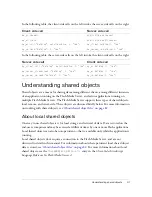
Understanding application flow
29
If you’re an administrator, you’ll use the management console to configure Flash Media
Server, set up system security, monitor usage, start and stop the server, and add users. For
more information on administration tasks for Flash Media Server, see
Managing Flash Media
Server
.
Understanding application flow
This section explains in more detail how the Flash client connects to the server, how shared
objects are accessed, and how remote methods can be invoked.
When the user runs your Flash SWF file and the SWF file connects to the server, the server
loads the application and creates the application instance if it isn’t already running. The server
accepts the connection, creates a new server-side Client object to represent the client
application on the server, and executes any server-side scripts that you provide. The server-side
Client object corresponds to the client-side NetConnection object that was used to connect to
the server; this Client object is only accessible through server-side script.
The client also does its work, initiating streams, sharing objects, and so on. The following
sections describe this sequence of events in more detail.
Flash Media Server
Sends/receives
data stream
Clients running the Flash Player
Administration Console
Configuration
Security
Monitoring usage
Summary of Contents for FLASH MEDIA SERVER 2-DEVELOPING MEDIA
Page 1: ...Developing Media Applications ...
Page 6: ...6 ...
Page 10: ...10 About This Manual ...
Page 36: ...36 Flash Media Server Architecture ...
Page 80: ...80 Debugging and Monitoring Applications ...
Page 106: ...106 Application Development Tips and Tricks ...
Page 114: ...114 ...
















































